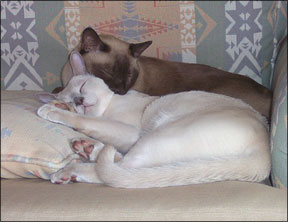It seems that nearly every week, a concerned cat person asks me that question. It could be that one cat in the household has recently passed away. Sometimes, a person has a bit more love to give, and just wants to share her home with more than one cat. And most often, people who work long hours hope that by adopting another cat, the original cat wont need to spend those hours alone.
Unfortunately, there is no simple answer to that seemingly simple question. For years, we described cats as asocial. They hunt alone, so it was assumed that they

Bev Caldwell
288
lived alone and wanted to keep it that way.
Research has revealed that, indeed, some cats are not very social. They are loners and do not choose to spend their time in the company of others.
But many cats are quite social and choose to congregate in groups. They may continue to explore and hunt alone, but they return to their own community for rest and relaxation. Furthermore, individual cats express preferences regarding which cats they prefer as close associates. The bottom line is that cats simply like certain cats better than others.
And herein lies the challenge. Suppose you plan to adopt a new cat. You know your cat is social since he has in the past lived amicably with other cats. But will he appreciate the particular cat that you choose to bring home? Can we play matchmaker? And once we make that educated guess as to which is the right housemate for our cat, how do we go about testing that theory?
It is truly difficult to determine whether two cats will be compatible. The best one can do is to follow some guidelines. First, if possible, select a cat that appears comfortable with the other cats in the adoption area. If you are adopting from an individual, learn whether there have been other cats in the home, and whether this particular cat interacted appropriately with the other household cats. Of course, this information may not be available. And, as mentioned earlier, a cat may get along nicely with one cat but not another. But any indication that this is a social cat is a plus.
Next, choose a cat that appears calm. A cat that startles easily in response to sounds or visual stimuli may run away quickly, thus triggering your cat to pursue aggressively. Or the frightened cat might redirect aggression toward your cat.
Another useful test is may be done to assess the new cats tolerance of gentle handling. If he leans against a brush as if the touch is pleasant, then he may enjoy being groomed by another cat as well. Mutual grooming can help strengthen a bond between cats.
Try to engage the cat in play. Does he play calmly and appropriately? If so, we can hope that he enjoys a bit of fun and may be able to play with your own cat. Also, you may be able to use shared object play to facilitate the introduction of the cats.
Similarly, a cat that loves food may be an easier cat to work with should behavior modification be needed during the introduction. Try luring the cat around the room with a food treat.
Okay, you have selected a calm cat that enjoys being petted and groomed. He engages in play and will work for food. He does not appear threatened by other cats in the area, and may even show a friendly interest in these cats. So home he goes.
Get Off to a Good Start
What now? Many people just put the cat on the floor and say, “Here is your new brother.” Sometimes, that can work. The problem is, when it does not work, we have set ourselves up for failure. It is much easier to prevent a behavior problem than to cure one.
Before allowing both cats free access to one another, it is important to learn to recognize subtle threats. You will need to watch very carefully. You will need to intervene before any serious aggressive or fear based responses are triggered. Although stares and body blocks are aggressive challenges, the staring cat can usually be helped. Once the cat growls and chases, it may be too late.
On the other hand, the cat that retreats even slightly is expressing fear. If we see this retreat in the absence of any apparent threat, then again, we can help.
Behavior modification can be used so that the cats are able to relax in one anothers company. Then, we can begin a smooth, injury free adoption.



